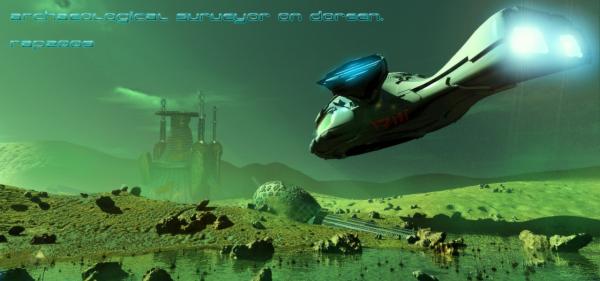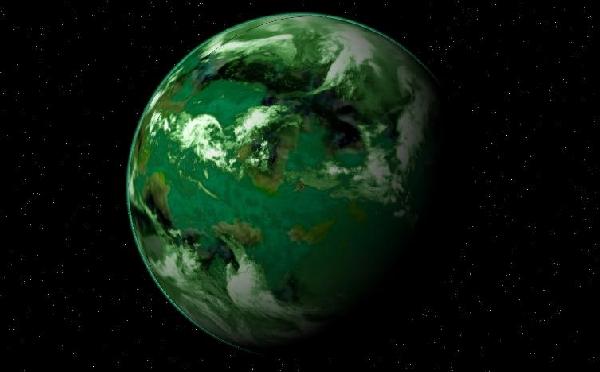BY LETTER
Doreen/Doreens
History > -13.7Gy to -7000 AT: Preterragen Era
Galactography > Regions of Space > Outer Volumes
Galactography > Systems and Worlds > Systems & Worlds C - D
Science > Biology > Xenobiology
Sophonts > Xenosophonts
Galactography > Regions of Space > Outer Volumes
Galactography > Systems and Worlds > Systems & Worlds C - D
Science > Biology > Xenobiology
Sophonts > Xenosophonts
 Image from Richard Patterson | |
| A probe exploring the chlorine-rich atmosphere of the world Doreen | |
| System | Star: Omicron Afri, Latakaia Type G6V Mass 0.93 x Sol Constellation Scorpio Distance from Sol 3528 ly Reached 7980 AT Planet Doreen Type NeoBiotic ChloroGaian Chlorine World Radius 7708 km Mass 1.89 x Earth Gravity 1.3 x Earth |
|---|
Early History of Doreen
Doreen was a lifeless planet 0.78 gigayears ago, until it was terraformed by the Halogenics, a chlorine-breathing culture who created many similar biospheres in the Galactic Habitable Zone of that period.Although the Halogenic culture died out 780 million years ago, many of their altered planets have continued to thrive since that time. In some cases evolution has produced new, advanced species on these worlds, occasionally including fully sophont beings. The chlorine world on Doreen (Omicron Afri II, beyond the Butterfly Cluster) generated a sapient species about four million years ago, however this species is now also extinct.Archaeological research by scientists from the Sagittarius Cooperation has shown that this species developed a technological civilization, achieved interplanetary travel, and created artificially intelligent machines. This set of advanced cultures then apparently destroyed itself in a system-wide war or series of wars that involved a nuclear exchange and germ warfare on the home planet, cometary bombardment of targets throughout the system, self-replicating machines, and an ecological and economic collapse so profound that the entire species became extinct.
Doreen Characteristics
According to the evidence the Doreens (so named after their planet, since their own name for themselves is unknown) were heavy users of fission-based nuclear power, partly because of the relative abundance of such materials on their world, and they drew very heavily on the massive coal-like deposits typical of chlorine worlds as well. This abundance of energy was likely a factor in their swift transition to Interplanetary level technologies once civilization arose. Reconstructions show that they were quite large, triradially symmetrical (quite unusual in a motile species) and individually of superbright intelligence. The remains of numerous and extensive military installations suggest that the most aggressive of their cultures were predominant. The biosphere that generated the Doreens was severely damaged, not only by the final wars but also by extensive resource exploitation in the preceding centuries. It is not expected to recover for some millions of years yet. There are life forms comparable to arthropods, but all larger and more complex forms of animal life are believed to be extinct. There are many ruins but no working mechanical installations or bot life on the planet itself. Image from Steve Bowers and John M Dollan | |
| Doreen from orbit | |
The Doreens had begun intensive exploitation of their entire star system's resources at the time of their demise and in the process had established a number of insystem colonies and space habitats. They also appear to have been engaged in the production of generation ships shortly before the wars broke out. Whether any of these ships were ever launched — and if so where they might be now — is unknown. Just as on the home planet, all records in the abandoned Doreen habs about the system seem to have been destroyed or erased and there are no functional bots or other machines. Few of these former settlements are even intact, most of them having been reduced to drifting orbital rubble that seems to have been scavenged for useful materials.
The Doreen Transapient
The Doreen system was not entirely uninhabited when it was first discovered. The second species of xenosophonts to inhabit this system created an automated infosphere which survived them, and this entity evolved into an artificial amechosystem with its own priorities. The mechosystem underwent subsequent development and transcension, and in the Gaiacene it is dominated by a single alien entity. The toposophic level of this entity is roughly equivalent to a Terragen transapient of S:1 level. This being is extremely hostile toward all other life forms, particularly bionts.Early attempts on the part of researchers from the Sagittarius Cooperation to engage the Doreen transapient in dialogue met with failure. There has since been some limited contact between this transapient and the Caretaker Gods, but the results were disappointing to outsiders. In the end, entry to the system was forbidden to S<1 entities other than those operating under the close supervision of a transapient representative of the Caretakers. Several groups have expressed interest in attempting to lazurogene the original Doreen bionts, but if it is available at all the necessary information for an authentic restoration is under embargo.
Some believe on the basis of available evidence that the Doreen transapient precipitated the final wars in the Doreen system.
Related Articles
- Chlorine Worlds
- Chorus
- Jade Chime Singers
- Xenecology - Text by M. Alan Kazlev
Study and application (in habitat design, biospherics, etc.) of alien (non-terragen) ecologies. - Xenobiont
Appears in Topics
Development Notes
Text by Stephen Inniss, expanded and amended from original material by Anders Sandberg
Initially published on 19 November 2004.
Initially published on 19 November 2004.






